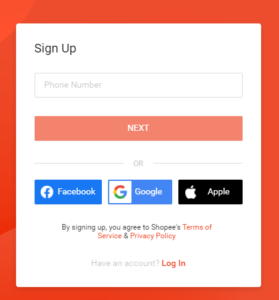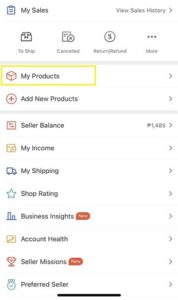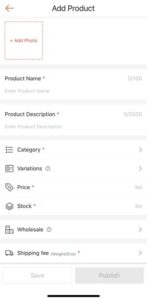Get To Know Startup Incubators in Singapore
Looking for that big break? Startup incubators in Singapore can turn your ideas into actionable plans. Find out more about them through Spenmo.
With millions of buyers daily on its platform, Shopee Singapore presents a wealth of opportunities for businesses.
In Singapore, where the outlook for retail had been bleak prior to the pandemic, the e-commerce industry was an outlier as total web visits to online selling platforms surged 23% in the first six months of 2020, according to Malaysia-based online shopping aggregator iPrice. This reflected a prevailing trend in many countries in Southeast Asia and the rest of the Asia Pacific, where e-commerce is projected to expand 8.2% from 2020 to 2025, outpacing growth expectations for other regions such as the U.S. and Europe.
At the center of this booming e-commerce, the trend is Shopee, one of the leading online selling platforms in Southeast Asian countries like Malaysia and the Philippines, as well as Taiwan. In Singapore, Shopee emerged as the top e-commerce site in the second quarter of 2021, with more than 13.5 million monthly web visits. Lazada on the other hand is far second with 7.5 million web visits.
Launched in 2015 in Lion City, the e-commerce giant operates under Singapore-based tech conglomerate Sea Group, which also owns online game developer Garena. Shopee’s popularity makes it a prime option for many who want to foray into online selling, either as a first-time business owner or an existing one.
If you are thinking of becoming a seller on Shopee Singapore, here’s a step-by-step guide on how and where to start and leverage your resources.
Becoming a Shoppee seller is easy and it offers many benefits to e-commerce businesses. We take you through the step-by-step process below.
If you are a new user, download the Shopee app on your phone and register an account. You’ll need to provide information such as your email address, Facebook account, and phone number. The last one is important as this is where the one-time password will be sent when you want to withdraw money from your earnings or top up your wallet. Make sure that your username is related to your business.
Aside from the app, another option is to register via the Shopee website. To do this, just go to Shopee.sg’s Seller Centre, click the Sign up button and follow the same steps above.

Once you have verified your account via email, you can now log in on Shopee.
If you are using the mobile app, click Me > My Shop > Add new products

This will redirect you to a page where you can upload the photos of your products and key in specifications and other details. To upload a picture, click Add Photo. You can either take the photo through the app or select existing images from your phone’s gallery. Up to nine photos are allowed per listing.
After this, supply the fields below the photos with the necessary information. These include:

Once you have supplied these details, click Publish and your products are live.
As one of the largest e-commerce platforms, Shopee has established a partnership with logistics companies that make shipping more convenient and affordable for sellers and their customers. In Singapore, for example, Shopee has tied up with the likes of Speedpost Economy, Ninja Van, J&T Express, and UrbanFox, among others, when delivering their parcels.
Similar to its competitor Lazada, Shopee.sg also regularly gives out free shipping vouchers (or shipping discounts) that will make your products more attractive.
With millions of visits daily, a user-friendly mobile app and website, and campaign promotions, Shopee offers a solid online presence that is hard to beat if you are starting from scratch. Sellers also get to benefit from Shopee Singapore’s marketing campaigns by making sure that new customers are added to its base regularly.
Shopee’s massive online presence means you get to have access to its large customer base. As of the second quarter of 2021, Shopee recorded more than 13.5 million web visits, outstripping rivals such as Lazada, Amazon, and Qoo10. Just think of how many customers–many of whom already have the intent to buy–your shop can reach when you start selling on Shopee. And since the Shopee app is geared for mobile use, you can penetrate your customers’ lifestyle, meaning your shop is just a tap and scroll away even when your potential customers are going about their normal day-to-day routine.
Shopee offers various payment methods such as debit or credit cards, PayNow, and DBS PayLah!. Customers can also use ShopeePay, the e-commerce platform’s digital wallet within its mobile app that lets them pay for all Shopee purchases straight from their account. ShopeePay only needs to be linked to a local bank and topped up with enough funds to facilitate the payment. Local government officers can also add corporate billing when paying for their Shopee purchases worth no more than S$6,000.
Having these various payment methods will help encourage customers to buy your products, especially the younger generation who prefer cashless transactions. In other countries like the Philippines, Shopee supports a payment method called cash on delivery where customers will only have to pay for their order upon delivery. In Malaysia, Shopee allows installment payment options with its partner local banks.
Another advantage of using the Shopee app for your business is its interface with intuitive features, which are beneficial from the seller’s and customers’ perspectives. For example, the Shopee mobile app enables one to filter options when searching for a product. These filters include price range, product category, location of the seller, shipping options, shop rating, and brands. Once you download the mobile app, everything should be smooth sailing from there as Shopee’s interface is less cluttered and more straightforward.
You can also easily add and update product information so customers have a better idea of what to expect from your listing. When adding a product, Shopee requires sellers to indicate the number of available stocks per product, helping you to automatically keep track of your inventory for every item sold.
On the marketing side, sellers greatly benefit from Shopee’s built-in analytics that gives insights into their weekly performance. Specifically, this data analytics tool identifies which products are selling well and how many customers have viewed a certain product. Sellers are also provided with customer insights that they can use to leverage their products.
Communicating with your buyers–potential or existing ones–can be a headache. But it remains an integral part of maintaining a business as this can make or break a sale. With Shopee Singapore, you can chat with your customers directly from the mobile app to sort out clarifications and other inquiries.
You can also set up an automated message to target those buyers who have your products added to their carts but have not made the purchase yet. This type of targeted marketing helps you personalize communication with your potential buyers without sounding too pushy. If you are unavailable for a certain period, you can change your status to vacation mode to avoid penalty points. To do this, just go to My Shop > Seller Assistant > Shop Setting > and then click Vacation mode.
For customers, Shopee Singapore has made it easy to request refunds or returns, as well as rate the products through reviews. They can also see the chat rating performance of the sellers to see how fast they are likely to respond to messages.
You do not have to spend a single cent when selling on Shopee. The app is downloadable from Apple’s App Store and the Google Play Store for free. Unlike when you build a website from scratch, you can create an account and start listing your products on Shopee at no cost.
However, you have to pay a certain fee if you want to be listed on Shopee Mall, which is often reserved for established manufacturers, businesses, and sellers. Those who are listed as a Shopee Mall are typically seen as more credible and authentic by the buyers. Think of it as an exclusive club whose members get to boast an invisible seal of approval. As of writing, a fee of US$315 is needed to be listed on Shopee Mall as required by Singapore’s Accounting and Corporate Regulatory Authority (ACRA). However, many businesses on the e-commerce platform have thrived even without Shopee Mall and you can always start selling without registering under this feature.
Additionally, Shopee makes money by taking a cut from every item sold on its platform. This fee is automatically deducted once you make a sale. Let’s talk more about this and the other fees that Shopee charges to sellers in the next section.
Like Lazada, Amazon, Qoo10, and other e-commerce platforms, Shopee takes a bulk of its revenue from transaction fees, which apply to the final payment amount per transaction.
For Shopee.sg, a transaction fee of 2% of the total amount for every successful order applies, after deducting promotions such as free shipping and coin cashback. This is applicable to sellers on the Shopee marketplace and Shopee Mall. On top of that, a 7% GST is also applicable to the transaction amount, per local laws.
To illustrate: an order with a final payment of S$200 (after vouchers) will incur a transaction fee of S$4 (S$200 x 2%). A GST charge of 7% will then be applied to the transaction fee, incurring an additional S$0.28 (S$4 x 7%). This means that of the S$200, the final amount that will be remitted to the seller is S$195.72 (S$200 – S$4.28).
It is worth noting that these transaction fees vary per country. In Southeast Asia, these fees typically range between 1.5% and 2.5%. They also differ when it comes to how they are applied. For example, in Shopee Indonesia, there is a commission fee that depends on the product category and a separate transaction fee that depends on the buyer’s chosen payment method.
While e-commerce platforms share a common denominator of operating 100% online, they also vary depending on their business models and how they generate sales. In this section, let us discuss the different types of e-commerce businesses on Shopee based on their revenue model.
Dropshipping on Shopee Singapore is an e-commerce fulfillment method where a business owner advertises a product and passes all orders to a third-party manufacturer, who then delivers the item to the customer. In other words, dropshipping lets you act as the bridge between the customer and third-party supplier without the burden of keeping stock of any product or maintaining inventory. This is a popular e-commerce model because it does not require much capital, manpower, and overhead costs.
White labelling is product rebranding. This happens when a manufacturer or supplier removes their brand or logo from a product and replaces it with the branding requested by the client, who then sells the said product as their own. The repackaged and the rebranded product is no longer owned by the original manufacturer but by their client. That is why you would often see a lot of products on Shopee, Lazada, and Amazon that look exactly the same but come from different brands or bear varying logos.
In a nutshell, manufacturing refers to the process of making a product from scratch. It covers the end-to-end process of creating goods in-house prior to selling them. One of the world’s biggest manufacturing powerhouses is China, where the industry makes up a huge chunk of the country’s economy. That is why it is not uncommon to see a plethora of products on Shopee that are directly being shipped from China provinces as these are where large factories are located; hence, they come at cheaper price tags, too.
But manufacturing is not limited to large-scale operations where assembly lines and thousands of factory workers are involved. Even a mom-and-pop shop selling baked goods made in-house is considered a manufacturer as the products directly come from the store.
E-commerce platforms on Shopee.sg that support wholesale sell goods in large quantities at a discounted price. Retailers will then sell these goods to end-consumers for a profit. Most wholesale sellers require a minimum order quantity to afford the discounted price.
Although Shopee.sg is an intuitive, user-friendly online shopping platform, it has no place for the complacent. Given the number of sellers competing for the same product categories, making your store stand out has always been a challenge. Fortunately, Shopee has built-in tools and features that you can employ to improve your sales.
“My Campaigns” allows sellers to nominate products that can be featured on main or category pages. Once your nominees are approved, your products can get exposure on campaign banners on desktop and the mobile app. These products will also be included in Shopee’s email blast and targeted push notifications, helping boost your shop’s click-through rate. This built-in tool found in the Marketing Centre is free of charge.
Another way to boost your Shopee store’s traffic and revenue is by joining flash sale promotions. Did you know that a flash deal receives an average of 4,000 views per timing? That number is hard to beat if you are just relying on customers searching for your products on purpose. Sellers in Singapore can buy a slot for Flash Deal from sgsellersolutions, depending on which time slot you want your products to be shown. This not only boosts your shop’s visibility, but it is also a great avenue if you are clearing stocks.
Just like Lazada or China’s Alibaba, Shopee allows users to advertise their products on its platform. This feature can be found under “My Ads,” a built-in tool that helps boost the searchability of your stocks. Advertising on Shopee.sg comes in two options. First is keywords ads, where sellers bid for keywords related to their products. Once a buyer enters those keywords, your ad will be displayed alongside the suggested products on the results page. The other option is targeting ads, where sellers bid for “similar products,” allowing your ads to be placed on the page where the details of the products related to your items are located.
Another tactic among Shopee sellers is creating vouchers. Nothing attracts customers more than knowing that they can save up on their purchases. With Shopee Singapore, you can create and customize vouchers to lure more buyers and encourage them to buy more items from your store. For example, you can create discount vouchers when a certain minimum amount is met. You can also create discounts for specific products or vouchers when a user follows your shop. The great thing about this feature is that it gives you full control of the entire process, including how much you are willing to give as discounts and how long the duration of such campaigns is.
We all know the limitations of online shopping versus buying from a physical store. That is why it is very crucial to have great photos of your products to entice buyers. Make sure that the photos are taken from a well-lit place and are uploaded in good-enough resolution. Avoid pixelated pictures. If possible, take multiple shots of one product from different angles so the buyers have a better idea of what you are selling.
Aside from using good photos, it is also important to include a detailed product description. Whenever possible, include all the specs and features, and provide a catchy but accurate product name.
Business owners who are still operating in a traditional set-up, i.e. physical stores, will find a wealth of opportunities once they adopt e-commerce platforms such as Shopee. Signing up for an e-commerce site is much cheaper than creating your own website from scratch. You also get to enjoy built-in tools and other features such as market analytics, e-vouchers, and campaigns that can help boost your online presence and entice customers to buy your products. Additionally, Shopee sellers automatically get access to the e-commerce site’s millions of shoppers.
However, selling on Shopee is not a passive source of income. You have to constantly look for ways to make your shop and products stand out given the cutthroat competition in many segments. This is most prevalent among resellers who source their products from big manufacturers like those in China, which leads to multiple stores selling the same products. It is also important to study how Shopee works and keep yourself updated on its ever-changing rules and features for sellers and buyers.
Looking for that big break? Startup incubators in Singapore can turn your ideas into actionable plans. Find out more about them through Spenmo.
Learn how to wire money and discover the different types of wire transfer services available
Lazada is one of the most popular e-commerce stores in Asia for established brands and mom-and-pop retailers. Read more to find out how to sell on...
Sign up to get the latest news, updates, and special offers delivered directly to your mailbox